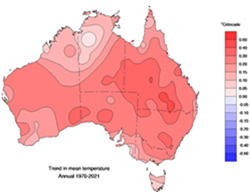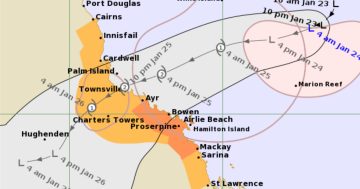 The Bureau of Meteorology (BoM) has tallied up its 2022 climate data, finding last year was wetter and warmer than average for NSW and Australia overall.
The Bureau of Meteorology (BoM) has tallied up its 2022 climate data, finding last year was wetter and warmer than average for NSW and Australia overall.
Releasing the data and a summary of key statistics, the Bureau said 2022 was NSW’s second wettest year on record, after 1950 which held on to the top spot.
“NSW overall had 860.24 mm rainfall in 2022, as an area average across the State, which is 54.7 per cent above average,” BoM said.
“The average temperature was 0.13°C warmer than the 1961-1990 average, while also being the coolest year for NSW overall since 1996.”
The Bureau said the national mean temperature was 0.50°C warmer than the 1961-1990 average, “making 2022 the equal 22nd warmest year on record since national temperature records began in 1910”.
It said national rainfall was 25 per cent above the 1961-1990 annual average – making 2022 the ninth-wettest year on record.
“Rainfall was very much above average for the south-eastern quarter of the mainland, where persistent rain saw significant flooding affecting large areas, multiple times during the year,” BoM said.
“Rainfall was below average for western Tasmania, much of the north of the Northern Territory, and the far south-west of Western Australia,” it said.
“Water storage levels have been high across much of Australia during 2022, although some storages were still low for parts of central coast Queensland, western Tasmania, south-east New South Wales and western Victoria.”
BoM said annual maximum temperatures were above average for most of northern Australia, Tasmania and parts of the west coast but below average for New South Wales, southern Queensland and parts of South Australia.
It said the year was characterised by wetter than average conditions across much of eastern Australia.
“Climatologically, these conditions were consistent with the wet phase of natural climate variability for our region – namely a La Niña, a negative Indian Ocean Dipole in winter and spring, and a persistently positive phase of the Southern Annular Mode from mid-autumn,” the Bureau said.
“The 2022–23 La Niña has been the third in a row,” it said.
“It is only the fourth time three successive La Niña events in a row have been observed in the Bureau record since 1900 (with the others being 1954-57, 1973-76, and 1998-2001).”
BoM said a full analysis and report on 2022’s rainfall, temperature, water storages and climate influences in relation to long-term climate trends would be released next month (February) in its Annual Climate Statement for 2022.
The Bureau’s 2022 climate data can be accessed at this PS News link.











